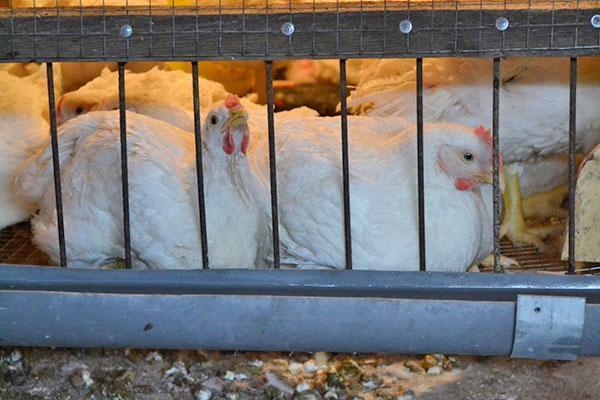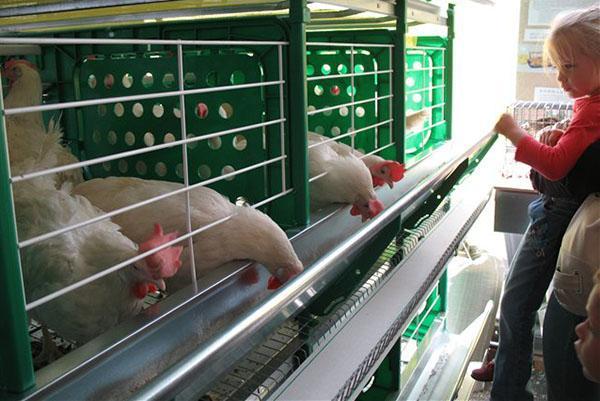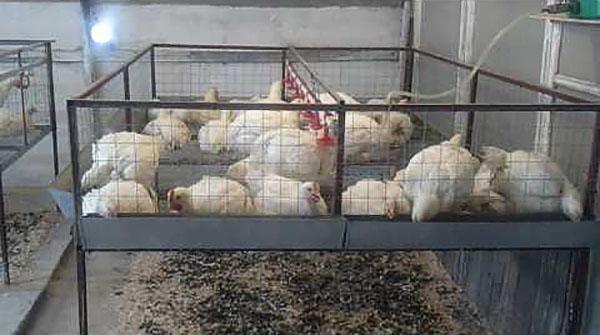How to properly grow broilers in cages or what conditions need to be created for chickens
 Novice poultry farmers are wondering which is better - growing broilers in cages or in a special pen. To make an informed decision, you need to have complete information about the correctness of keeping chickens. Broilers are bred for the sake of gain in a short time, accordingly it is important to create favorable conditions for the chickens so that they develop correctly.
Novice poultry farmers are wondering which is better - growing broilers in cages or in a special pen. To make an informed decision, you need to have complete information about the correctness of keeping chickens. Broilers are bred for the sake of gain in a short time, accordingly it is important to create favorable conditions for the chickens so that they develop correctly.
Advantages and disadvantages

The pluses include a number of criteria:
- Saves space. This means that energy costs will also be reduced as the chicks need light, heating and ventilation.
- The consumption of feed is significantly reduced. This is due to the fact that the chickens do not scatter feed and do not trample on it.
- Due to the limited movement, the mass gain occurs faster, since the energy is spent on growth, and not on movement.
- When broilers are raised in cages, they have less contact with other individuals. This communication is limited to neighbors in the cage, which allows timely action to be taken when the infection spreads.
- Easier daily cleaning. It also helps to reduce the risk of spreading the infection, plus the chick does not peck at its droppings or breathe ammonia.
- Bird care is more streamlined. This includes not only drinking and feeding, but also a veterinary examination, which must be carried out daily.
For large-scale production, a big plus will be precisely a faster weight gain, which will significantly increase profits, since fattening will be less for a week, in comparison with floor keeping.
 The disadvantages include indicators such as:
The disadvantages include indicators such as:
- high costs for equipment and cages;
- creating a special climate in a room with birds - light, temperature, ventilation;
- you will have to purchase special feed for balanced nutrition chicken;
- the occurrence of problems with the legs when reaching a large weight, occurring due to being on a mesh floor;
- daily cleaning of litter trays is mandatory;
- taste indicators are lower than that of free-range chickens.
After freeing the cage from the chickens, disinfect it to exclude possible contamination of the next batch of broilers.
Private house cages
 In order for the maintenance of broilers in cages at home to be correct, you need to prepare in advance. First of all, choose a room, purchase the necessary equipment and purchase cells. You can build them yourself or buy a ready-made industrial version. Any room can be used, for example, a barn. In summer, cage rearing is possible outdoors.
In order for the maintenance of broilers in cages at home to be correct, you need to prepare in advance. First of all, choose a room, purchase the necessary equipment and purchase cells. You can build them yourself or buy a ready-made industrial version. Any room can be used, for example, a barn. In summer, cage rearing is possible outdoors.
You need to remember about the temperature regime. Overheating will adversely affect bird health.
The equipment includes:
- lamps for lighting, as chickens quality constant light is needed for proper development;
- special heating elements, since chickens need a high air temperature - starting from 36 degrees, which gradually decreases to 18 degrees as they grow up;
- ventilation mechanisms necessary for the comfortable and healthy development of the bird.
- feeders and drinkers.
Growing broilers at home in cages means purchasing or making a cage on your own. You can buy it by choosing from a variety of factory-made models. In this option, it remains only to choose the size and equipment of the cage. Many manufacturers sell cages with built-in feed and water feeding mechanisms, as well as automatic cleaning of the litter tray.
To make a cage with your own hand, it is advisable to first familiarize yourself with the video of broilers in cages at home. There are different cell options. It will be easier to navigate the views - what materials are easier to make and more convenient to use.
 First, a frame is built. It can be made both from a bar and from a metal profile. Further, a grating for the walls and floor is attached to it. Walls can also be made of plywood, but the ventilation will be much better when the grille is installed. The bottom of the cages needs a fine mesh cage to avoid injury to the chicks. Some manufacturers install plastic pallets together with nets. Galvanized sheets are prepared and installed under the cage floor. It is advisable to make them removable for the convenience of handling and cleaning the droppings.
First, a frame is built. It can be made both from a bar and from a metal profile. Further, a grating for the walls and floor is attached to it. Walls can also be made of plywood, but the ventilation will be much better when the grille is installed. The bottom of the cages needs a fine mesh cage to avoid injury to the chicks. Some manufacturers install plastic pallets together with nets. Galvanized sheets are prepared and installed under the cage floor. It is advisable to make them removable for the convenience of handling and cleaning the droppings.
Content standards
 When broilers are grown in cages, you need to adhere to zootechnical standards:
When broilers are grown in cages, you need to adhere to zootechnical standards:
- On average, 1 sq. m. should have an average of 23 heads, while the weight at the finish line should not exceed 40 kg.
- With groove feeding, it is necessary to allocate about 2.5 cm for 1 chicken. When feeding from a round container, there should be, on average, 50 individuals.
- With a vacuum drinker, which is produced in the early days, a ratio of 50 chicks to 1 drinker must be observed. Further, with the grooved version, it is enough to allocate 2 cm per head.
- Compliance with temperature standards. When the chicks are still small, the temperature is maintained at about 36 degrees. After, decrease by 0.2 degrees every day. Thus, at week 7, the temperature should reach 17-18 degrees. With her, in the future, and contain adults.
- You need to pay attention to moisture. It should be around 60%. The well-being of the bird, its respiratory system and the feeling of temperature depend on the correct setting of humidity.
- It is important to follow the light regime. If for small chickens almost round-the-clock lighting is needed, that is, 23 hours a day should be illuminated with high-quality light. As you grow older, on day 7, you need to switch to day / night mode. The light period will be about 17-19 hours.
It will take about 70 days to grow broilers at home in cages. After that, the chicken begins to gain weight more slowly and consume more feed. Accordingly, there is no point in growing it further. But even at this age, the weight of the broiler will be about 2.5 kg.